
4 Elementary Teaching Styles
Reviewed by Jacob Imm
Nov 18, 2022
4 Elementary Teaching Styles
You’ve just figured out everything you need to know about how to become an elementary education teacher. However, in the modern classroom, how you teach may be just as important as what you teach. This notion may be especially true for elementary school, when young minds are in the early stages of development.
Although you may have only experienced the “traditional” method of instructor-centered teaching throughout your schooling, there are actually several different teaching styles—unique ways to run your classroom and deliver lessons to your students. Each style approaches education in its own way, and each has an impressive list of advantages and disadvantages when it comes to a different learning environment.
In this guide, we’ll touch on the pros and cons of various elementary teaching styles: instructor-focused, student-focused, student-led, and collaborative-driven. If you’re considering a career in elementary education, it’s worth understanding the possibilities that diverse teaching styles can bring.
1. Instructor-Focused Teaching
Instructor-focused teaching—the approach to education that involves a central figure guiding the learning experience—is probably the most well-known teaching style. In instructor-focused teaching, one authority figure holds the reins and takes students through the learning material. You may also hear the term “teacher-centered learning” used to describe this teaching style.
Some examples of instructor-focused teaching include:
- Lectures
- Slideshows
- Demonstrations
Perhaps because of its prevalence in the school system, instructor-focused teaching also exists outside the classroom. Whether you’re training at a new job or learning an instrument, you’ll often take directions from an instructor.
The Benefits of Instructor-Focused Teaching
First of all, instructor-focused teaching is familiar because it’s an effective teaching style. From kindergarten through senior year, this teaching style dominates most classrooms. Because of its effectiveness, most students will immediately understand what’s expected of them.
And instructor-focused teaching is famous — because it promotes discipline and listening. In many cases, the rigid guidelines that instructor-focused teaching provides are necessary. For example, if deviating from the steps of a science experiment can lead to unsafe conditions, strict rules are essential.
The Drawbacks of Instructor-Focused Teaching
For many, instructor-focused teaching will feel like the “right” choice—after all, it’s the traditional method of teaching in most public schools. However, just because instructor-focused education is the norm doesn’t mean it’s the best option for every situation.
When the teacher sets the pace and the curriculum, there is little room for student learning and exploration outside of the given instructions. Students must follow the instructor’s guidelines; otherwise, they risk consequences.
There’s also an implicit expectation that all students perform at the same level—and as you’ll probably remember from your days in elementary school, a one-size-fits-all model doesn’t always work.
2. Student-Focused Teaching
As the name suggests, student-focused teaching shifts the attention from the instructor to the learner. Also known as “learner-centered education,” this teaching method opens up a two-way dialogue between teacher and student and among students.
Teaching strategies under student-focused instruction include:
- Cooperative learning – Cooperative learning encourages students to work in pairs or groups. These groupings can be informal (such as post-lesson discussion pairings) or formal (as in the case of group projects).
- Active learning – This philosophy encourages kids to be active participants in their learning (as opposed to passive participants, as is sometimes the case with instructor-focused teaching). Anything from individual reflection to group learning can be a form of active learning.
A common misconception about student-focused learning is that the instructor no longer participates, but that idea couldn’t be further from the truth. Teachers still play a role in monitoring and evaluating student work.
The Benefits of Student-Focused Teaching
When students have a say in what, when, and how they learn, they can become more engaged and are less likely to lose focus—even as early as kindergarten.
Moreover, placing students partly in charge of their learning helps them acquire a sense of responsibility.
Finally, student-focused strategies like active learning are often the norm in post-secondary institutions. Bringing this teaching style into the elementary classroom can help prepare students for the future since there’s more student involvement.
The Drawbacks of Student-Focused Teaching
As you might expect from this different learning environment, some students may struggle without an instructor to guide them every step of the way. While this highlights the independence that student-focused teaching can reinforce, it can be challenging for some to adapt to this change.
Additionally, some students may take advantage of less rigid guidelines. Instead, time meant for journal writing, personal reflection, or group discussion may be spent on unproductive activities.
3. Student-Led Teaching
This teaching strategy (which often goes under the name of Montessori) places students at the helm of their own learning. When you take the student-led approach as an elementary school teacher, your role is to provide content and materials for children, then allow them to follow their interests and come to you for guidance.
Although student-led teaching sounds a lot like student-focused teaching, there’s a difference in the degree of input from the instructor. In student-led education, the instructor maintains order and facilitates lessons, but their primary job is to act as a resource for inquisitive minds.
Student-led teaching also places importance on holistic education. Beyond intellectual learning, students in Montessori-type environments may explore other kinds of schooling more directly, including:
- Emotional
- Social
- Physical
The Benefits of Student-Led Teaching
Pupils in a student-led classroom have continuous opportunities to learn first-hand about self-motivation. They can also experiment with how and when to ask for help.
Perhaps most importantly, student-led learning can be more fun. A student with the freedom to pursue their interests may be happier and more inspired to learn. And because one of the primary goals of elementary education is learning how to learn, student-led teaching can be a terrific way to reach that goal.
The Drawbacks of Student-Led Teaching
While some students may find the lack of formal direction liberating, others may struggle without traditional structure. One of your duties as an elementary teacher in a student-led classroom is to support this latter population with more instructions.
Additionally, because this different teaching style requires plentiful materials and resources, it can be cost-prohibitive. Schools looking to implement student-led teaching may need to raise funds from parents or the community or seek out an educational grant to cover newfound expenses.
4. Collaboration-Driven Teaching
This teaching style relies heavily on grouping students. The philosophy behind collaboration-driven learning is that it more closely reflects the “real world.” Students may work in pairs, small groups, or even as an entire class to solve problems and explore complex topics.
While collaboration is a part of the student-focused and student-led teaching styles (and even in the traditional instructor-focused environments), it’s the focus here. Students complete nearly all assignments and examinations in groups.
One well-known example of collaborative teaching is project-based learning. In project-based learning, the instructor gives groups of students a broad, open-ended question to answer. The students must then work together on a report or presentation that explores the topic in depth.
The Benefits of Collaboration-Driven Teaching
Collaborative learning shows that students can learn from each other as much as they can from an instructor. In fact, in some cases, students respond better to feedback from their peers than from their instructors.
Collaboration-driven learning prepares elementary students for college and beyond, where teamwork is vital. You set them up for success when you encourage your students to work with a diverse group of others at an early age.
The Drawbacks of Collaboration-Driven Teaching
At times, teachers may find themselves bouncing around too much between groups. But when the alternative is speaking with each student individually, you may end up saving time by grouping students.
However, groups aren’t for everyone. Some students won’t appreciate the near-constant social engagement that group work requires due to differing abilities or preferences.
Which Teaching Style is the Best?
As you probably discovered in school, there is no one-size-fits-all approach to teaching. What may be the “best” teaching method for one student likely won’t be the same for another.
Choosing the best teaching style means understanding your students’ learning styles. The four most widely accepted blended learning styles make up the VARK model:
- Visual – Those who learn by seeing.
- Aural – Those who learn through listening.
- Reading and writing – Those who learn by reading source materials.
- Kinesthetic – Those who learn by doing.
However, even these categories are too general. There’s a lot more nuance to learning and teaching. Overall, the “best” teaching style is one that adeptly uses different types for different subjects and different students.
Discover Your Preferred Teaching Style
Before you can start implementing one or more teaching styles in an elementary school classroom, you’ll have to learn how and when to use them. Enrolling in an elementary education degree program lets you learn about teaching styles and see how students respond to them in a real classroom.
When it’s time to apply to elementary education programs, finding a school that gives you hands-on opportunities is essential. Looking for more information on what you can do with an elementary education degree? Institutions like North Central College provide you with the practical knowledge and experience you’ll need to flourish at the head of a classroom—no matter which teaching style you prefer.
Jacob Imm is the associate director of communication in the North Central College Office of Marketing and Communications. He has 12 years of collegiate communications experience and has worked with hundreds of college students. He has a bachelor’s degree from the University of Notre Dame and a master’s degree from Northern Illinois University.
Sources:
The VARK Modalities. VARK. (n.d.). Retrieved September 21, 2022, from https://vark-learn.com/introduction-to-vark/the-vark-modalities/

